|
|
| |
|
COLLECTING 007 – UK Film Magazines
WRITTEN &
COMPILED BY KEVIN HARPER & GRAHAM RYE |
|
|
From the earliest days of
cinema the stars and their films have been promoted in numerous magazines
published throughout the world. In more recent years specialist publications have
focussed on other aspects of filmmaking including cinematography and
special effects. Pictured below is a comprehensive selection of UK
publications with significant material publicising the James Bond films
during production, and on their original release. Selected special features
(and restored double-page spreads often with photographs unique to that
particular publication), interviews,
portraits and
articles are also presented wherever possible. Before the advent of the
generic studio press kit, which saw all printed media and online platforms
publish the same carefully chosen key images, take a nostalgic look back at a
golden age of cinema-going courtesy of the 007 MAGAZINE Archive! |
|
|
|
Photoplay was a
monthly magazine
first published in the UK in 1950, featuring reviews of new films and
articles on the stars of the day, with the emphasis on
their private lives and interests. By the 1960s Photoplay also
included articles on pop stars and current television programmes (and
later
videotapes from the early 1980s), although
its main focus continued to be the cinema. Ironically, it was Photoplay
magazine that predicted Sean Connery would become a big star as early as
April 1958. Editor Ken Ferguson interviewed the up-and-coming actor as he
signed a contract with Twentieth-Century-Fox, opening his feature
article
‘What a hunk of he-man’ with the words: “I'm going to predict that by
the end of the year a young, burly, rugged Scots-man who grunts to the
name of Sean Connery will be a BIG star.” However, it would be another
four years before Connery got his first starring role in Dr. No
(1962). |
 |
|
Previously
unpublished and ‘unearthed’ from the 007 MAGAZINE ARCHIVE after 35
years, Ken Ferguson, the Editor of Photoplay recalls his
meetings with four James Bonds – and the man who created the character
of 007 in an exclusive feature article...
READ HERE |
|
|
|
The first coverage of Dr. No was in Photoplay's
July 1962 edition, which featured an article on Ursula Andress. The November 1962 issue
was available as Dr. No went on release across the UK, although editor
Ken Ferguson's interview with Ian Fleming was not advertised on
the cover, which instead showcased Elvis Presley (1935-1977). A year later
coverage of From Russia With Love began in the November 1963
issue, which focussed on British pop groups, this time featuring
The Beatles on the cover. The December 1963 issue
included a full-page colour portrait of Sean Connery as James Bond to promote From Russia With Love (1963), then enjoying its
record-breaking UK general release, however, it was popular English Pop
Singer Craig Douglas (1941– ) [birth name Terence Perkins] who was
featured on the cover of this issue. Craig Douglas recorded a
cover version of
Lionel Bart's ‘From Russia With Love’, and was
photographed with
gypsy fighting girls Martine Beswicke and Aliza Gur to promote the
single, which was released in October 1963.
The James Bond films
were then all promoted heavily upon their original release (and
frequently during production), with at least one cover each year from 1964 onwards devoted to the stars of the latest 007 blockbuster
(with the exception of A View To A Kill). Photoplay ceased publication in 1989 and was incorporated
into a new magazine called Film Monthly; which was still edited by
Ken Ferguson, assisted by his wife Sylvia. However, unable to compete with
new publications such as EMPIRE (launched in 1989) with its more modern style of journalism, Film Monthly eventually folded in 1992. |
|
|
|
|
|
ARGUS
SPECIALIST PUBLICATIONS 1983 |
|
|
Released in late 1983 to
take advantage of the so-called ‘Battle of the Bonds’ (which never really
materialised other than in the minds of the Media on the lookout for a
good story), Argus Specialist Publications [who also published Photoplay]
issued two 32-page pictorial souvenirs dedicated to the James Bond films
of Roger Moore and Sean Connery. Both magazines are full of textual and
pictorial errors throughout, and were ostensibly published
to promote Octopussy and Never Say Never Again, both
released in 1983. The Sean Connery issue “My Name is BOND”
also published stills and background information from the six EON
Productions films in which the actor starred from 1962-1971. Both magazines had an
identical
back cover promoting the UK release of Never Say Never Again on
December 15, 1983. |
|
|
|
|
|
|
|
The film magazine
Showtime was first published in January 1964 as the Rank Organisation's competitor to the
ABC Film Review, which was the rival publication for cinemas on
the ABC (Associated British Cinemas) distribution circuit.
Showtime only gave
publicity and praise to those films showing in Rank cinemas, and whilst
similar to ABC Film Review it also contained articles on fashion,
pop music and interviews with stars of the day, as well as film reviews and
advance publicity of forthcoming films. Originating as a 36-page
publication upon its launch, the first issue of SHOWTIME sold
177,859 copies. Sales of the February 1964 issue rose to 198,079; with the
March edition passing the 200,000 mark. From August 1964 the
page-count
was increased to 48, and by September 1965 SHOWTIME had
594,000 readers, far outselling its rival ABC Film Review, although
this success was short-lived and publication ceased after just four years. |
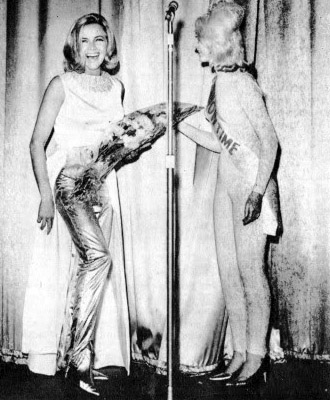 |
As the James Bond films were first
released in ODEON and Gaumont cinemas on the Rank circuit,
they were naturally promoted by
Showtime, and several covers were
also devoted to the series until the magazine ceased publication in 1967.
Showtime was only available to purchase [priced at 1/- (one
shilling)] in Rank cinemas, or by
subscription. SHOWTIME's film gossip column, edited by Tony Crawley,
would often feature fascinating titbits relating to the production of
the James Bond films, although not featured on the cover or reported
on in-depth within the magazine. One such item
appeared in the
July 1964 issue, and solves the mystery as to why many images of
Sean Connery in a white tuxedo from the 1964 film Woman of Straw
are often misidentified as being from Goldfinger (1964). Connery had
filmed the Basil Dearden directed drama at Pinewood Studios from
August to October 1963, before travelling to the USA to appear in
Alfred Hitchcock's Marnie (1964). The white dinner jacket was
one of six Anthony Sinclair tailored suits worn by
Sean Connery in
Woman of Straw that were sold to the Bond company for use
Goldfinger! In late September 1964 Honor
Blackman made personal appearances at six ‘PREMIERE SHOWCASE Theatres’ to promote the release of Goldfinger.
[Pictured left] Honor Blackman is presented with a bouquet of flowers at the
ODEON Bromley by
SHOWTIME's ‘Golden Girl’ Maureen Wilson. |
|
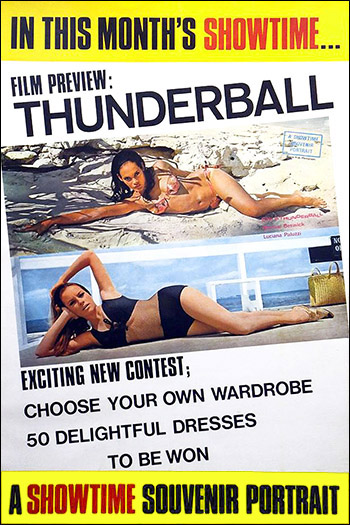 |
|
Honor Blackman was the first James Bond star to make the
cover in September 1964, with another 007 themed cover the following month
featuring starlet Jacqueline Jones (1934- ) as Honey Rider from Ian
Fleming's DR. NO (1958). Inside was
a five-page feature with the English actress photographed as six James Bond
girls:
Pussy Galore,
Tatiana Romanova,
Honey Rider,
Vespa Lynd [sic],
Tiffany Case, and
Tracy from ON HER MAJESTY'S SECRET
SERVICE (1963) - which was then planned as the fourth film in the EON
Productions series starring Sean Connery as James Bond.
Jacqueline Jones had earlier tested for the small role of Dink in Goldfinger
(1964) alongside Margaret Nolan at Pinewood Studios on December 13, 1963. SHOWTIME featured some
unique and interesting articles throughout its short history, including
a
1965 interview with
James Bond composer John Barry, and a 1967 feature on
stuntman
Bob Simmons. Published at the height of ‘Bondmania’ in the mid-1960s, hardly a month went by
without
Showtime featuring some exclusive James Bond content.
SHOWTIME ceased
publication with the December 1967 issue, and was superseded by
Showguide - a
pocket-sized free magazine available in cinemas on the Rank Distribution
circuit from February 1968.
|
|
|
|
|
|
|
|
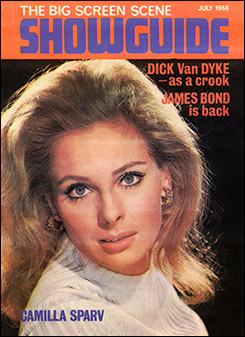 |
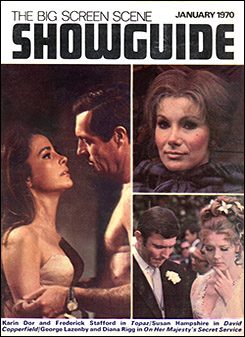 |
|
Showguide,
subtitled ‘The Big Screen Scene’, was a pocket-sized (7.5 X 5.5 inches
approx) magazine available free in cinemas on the Rank Distribution
circuit following the demise of SHOWTIME at the end of 1967.
Printed on very poor quality paper and with interior colour usually
reserved for advertisements, the booklet had a much smaller
page-count than its predecessor. SHOWGUIDE was replaced by Film Review which was available in all cinemas from
the early 1970s. With the collapse of the Hollywood studio system in
the late 1960s, films seen in UK cinemas were distributed by Rank, or the rival
ABC circuit, but the allocation between major studios was now less clearly defined. |
|
July 1968
Goldfinger/Thunderball Double-bill |
January 1970
Spread1
Spread
2 |
|
|
|
|
|
 |
& |
 |
|
|
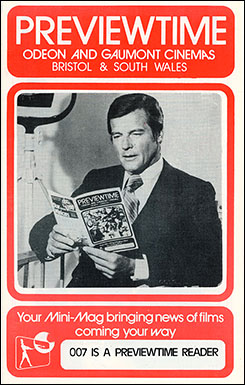 |
|
Following the demise of
SHOWGUIDE, The Rank Organisation would produce their own free monthly
booklet promoting the films on offer at ODEON and Gaumont cinemas. Originally produced in the 1970s as
a two-colour booklet (often
with a full colour double-page centre-spread) PREVIEWTIME,
featuring
simple photo spreads to alert moviegoers to the arrival of new
films at their local cinema. All of Roger Moore's James Bond films were
promoted via a double-page photo spread in PREVIEWTIME
and MOVIE GOER on their original release. By the late 1980s with
many cinemas converted to multi-screen venues, it was not practical to promote
current and forthcoming
attractions in a standardized regional monthly magazine, and a new more
focussed publication emerged.
PREVIEWTIME was
superseded by MOVIE GOER - a
generic A5-sized 18-page publication that would be customized by managers to
show the films on offer at a given cinema on the ODEON Chain that month.
MOVIE GOER also included
advertisements for local traders and was available to pick
up in cinema foyers alongside
confectionery, popcorn and the long-running commercially produced magazine
Film Review. Produced locally, MOVIE GOER later had a full
colour cover, but still retained the black & white photographs and
advertisements inside to keep printing costs to a minimum. Generally
discarded, these free booklets are now very hard to find on the collectors
market. MOVIE GOER was subsequently renamed ODEON Movie Goer,
ODEON Cinema Guide; and more recently ODEON Magazine,
which is still available free
in ODEON cinemas. |
|
June 1977
Spread 1
Spread 2
Spread 3 |
|
|
|
|
In addition to their
release on the ODEON chain, from 1995 the James Bond films starring Pierce
Brosnan and Daniel Craig were also exhibited in Cineworld cinemas.
The privately operated company is currently the world's second-largest
cinema chain, with over 9,000 screens across 751 sites in 10 countries.
The two cinema brands in the United Kingdom and Ireland are Cineworld
and Picturehouse - both of which published their own free booklets
advertising the films on offer at specific venues. An example of the
Cineworld booklet announcing the release of Die Another Day in
November 2002 is pictured above. |
|
|
|
|
|
Never Say Never Again
(1983) was the only James Bond film to be released exclusively on the ABC
circuit in the UK. At the time ABC cinemas were part of the Thorn EMI
Group, and new releases were promoted in a free monthly booklet (similar
to the one available in ODEON and other Rank cinemas) simply titled
PREVIEW. The December 1983/January 1984 edition featured Sean
Connery's comeback film as James Bond on the cover and a double-page
poster spread to coincide its nationwide release from Friday December 16,
1983 - two days after its West End
Charity premiere at the Warner Theatre in London's Leicester Square. |
|
|
|
Thursday December 15,
1983 (the day after its London premiere and a day before its general
release): Never Say Never Again had its Regional and Northern
Charity Premiere at the ABC Cinema in York – organised by the city's Lord
Mayor, Councillor Steve Galloway; with the help of this author and the
support of Graham Rye, then President of the James Bond British Fan Club.
Copies of the Club magazine ‘007’ sold well at the premiere, and Sean
Connery recorded a special message that was played in the auditorium
before the screening. The sell-out event raised £600 for The British Heart
Foundation and gave a much-needed boost to the local economy at the end of
a year that saw the lowest cinema attendance on record. There were
65.7-million admissions in 1983 – half the number recorded 10 years earlier.
The home video market continued to make a significant dent in cinema
box-office takings in the ensuing decade, and Never Say Never Again
was released onto the video rental market in July 1984, by which time its
cinematic lifecycle had almost ended. The film continued to play at
London's
Warner West End until late September, and received its television premiere
on BBC1 on Christmas Day 1986 – the shortest window yet for any James Bond
film. |
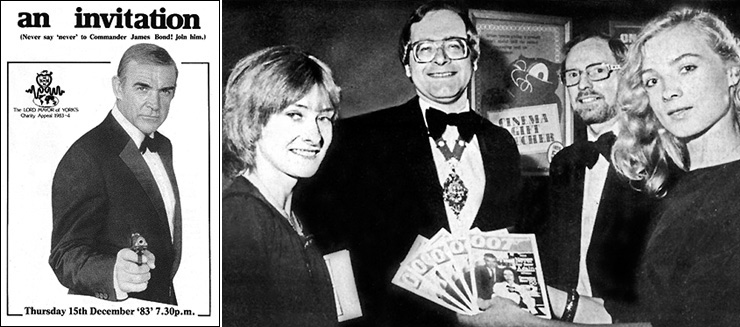 |
|
ABOVE: Model and
‘007’ seller Anna Froberg (right), and ABC manager Ken Lamb
(second right), greet the Lord Mayor and Lady Mayoress,
Councillors Steve and Sue Galloway at the Regional and Northern
Charity Premiere of Never Say Never Again held at the ABC
cinema in York on Thursday December 15, 1983. Assistant manageress
Violet Ashton said “I've never known anything like it in all my 29
years at the ABC. We've never had a premiere like this before”.
The Lord Mayor held a reception at York's Mansion House after the
screening, where attendees and local dignitaries were encouraged to
dress to impress. Although the Lord Mayor was a self-confessed
Bond addict, it was merely a coincidence that he had been able to
use the premiere of Never Say Never Again as a fund-raising
event to help charities during his year in office. |
|
|
|
|
|
CONTINUED >> |
|
